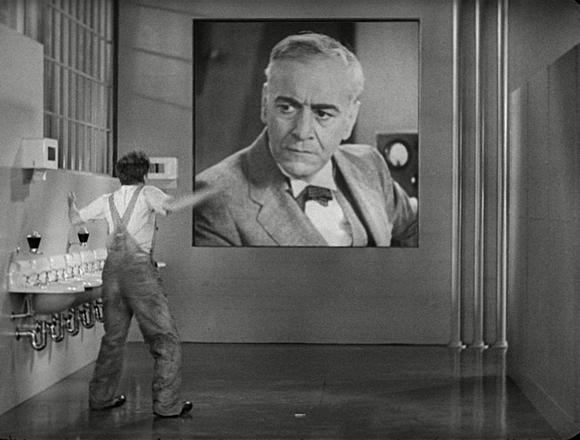“I have to take a photo,” the courier said, raising his mobile phone to snap a shot of the package on the stoop in front of my open doorway.
This has been the new thing. I guess the spoken reason is to ensure that the package recipient can’t claim that it was never delivered, protecting all three of the courier, the courier company, and the shipper from fraud. But it feels like the unspoken reason is to check that the delivery guy has faithfully completed his task and continued on his appointed round without wasting time. It feels, in other words, like the delivery guy is helping the company monitor him.
I say this, and he agrees. I had, in accordance with the demands of a different courier, pinned a note to my door authorizing the deliverer to leave the package on the doorstep in my absence. “I’d have to photograph the note,” he said.
I mentioned American truck drivers, who are pushing back against in-cab cameras and electronic monitors. “They want to do that here, too,” he said. “They want to put in dashboard cameras.” Since then, in at least some cases – for example, Amazon – they have.
Workplace monitoring was growing in any case, but, as noted in 2021, the explosion in remote working brought by the pandemic normalized a level of employer intrusion that might have been more thoroughly debated in less fraught times. The Trades Union Congress reported in 2022 that 60% of employees had experiened being tracked in the previous years. And once in place, the habit of surveillance is very hard to undo.
When I was first thinking about this piece in 2021, many of these technologies were just being installed. Two years later, there’s been time for a fight back. One such story comes from the France-based company Teleperformance, one of those obscure, behind-the-scenes suppliers to the companies we’ve all heard of. In this case, the company in the shadows supplies remote customer service workers to include, just in the UK, the government’s health and education departments, NHS Digital, the RAF and Royal Navy, and the Student Loans Company, as well as Vodafone, eBay, Aviva, Volkswagen, and the Guardian itself; some of Teleperformance’s Albanian workers provide service to Apple UK
In 2021, Teleperformance demanded that remote workers in Colombia install in-home monitoring and included a contract clause requiring them to accept AI-powered cameras with voice analytics in their homes and allowing the company to store data on all members of the worker’s family. An earlier attempt at the same thing in Albania failed when the Information and Data Protection Commissioner stepped in.
Teleperformance tried this in the UK, where the unions warned about the normalization of surveillance. The company responded that the cameras would only be used for meetings, training, and scheduled video calls so that supervisors could check that workers’ desks were free of devices deemed to pose a risk to data security. Even so, In August 2021 Teleperformance told Test and Trace staff to limit breaks to ten minutes in a six-hour shift and to select “comfort break” on their computers (so they wouldn’t be paid for that time).
Other stories from the pandemic’s early days show office workers being forced to log in with cameras on for a daily morning meeting or stay active on Slack. Amazon has plans to use collected mouse movements and keystrokes to create worker profiles to prevent impersonation. In India, the government itself demanded that its accredited social health activists install an app that tracks their movements via GPS and monitors their uses of other apps.
More recently, Politico reports that Uber drivers must sign in with a selfie; they will be banned if the facial recognition verification software fails to find a match.
This week, at the Guardian Clea Skopoleti updated the state of work. In one of her examples, monitoring software calculates “activity scores” based on typing and mouse movements – so participating in Zoom meetings, watching work-related video clips, and thinking don’t count. Young people, women, and minority workers are more likely to be surveilled.
One employee Skopoleti interviews takes unpaid breaks to carve out breathing space in which to work; another reports having to explain the length of his toilet breaks. Another, a English worker in social housing, reports his vehicle is tracked so closely that a manager phones if they think he’s not in the right place or taking too long.
This is a surveillance-breeds-distrust-breeds-more-surveillance cycle. As Ellen Ullman long ago observed, systems infect their owners with the desire to do more and more with them. It will take time for employers to understand the costs in worker burnout, staff turnover, and absenteeism.
One way out is through enforcing the law: In 2020, the ICO investigated Barclay’s Bank, which was accused of spying on staff via software that tracked how they spent their time; the bank dropped it. In many of these stories, however, the surveillance suppliers say they operate within the law.
The more important way out is worker empowerment. In Colombia, Teleperformance has just guaranteed its 40,000 workers the right to form a union.
First, crucially, we need to remember that surveillance is not normal.
Illustrations: The boss tells Charlie Chaplin to get back to work in Modern Times (1936).
Wendy M. Grossman is the 2013 winner of the Enigma Award. Her Web site has an extensive archive of her books, articles, and music, and an archive of earlier columns in this series. Follow on Mastodon or Twitter.
